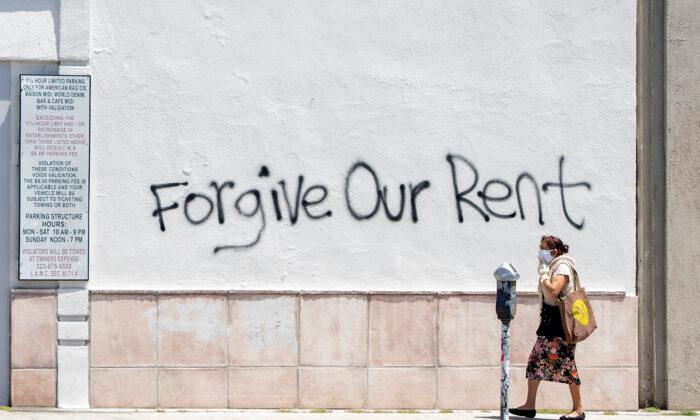ORANGE, Calif.—The Orange County Sheriff’s Department has resumed evictions that were in progress before California Gov. Gavin Newsom issued a moratorium at the start of the COVID-19 pandemic.
The department’s Civil Process Services bureau, which handles the county’s evictions, began contacting tenants on May 26 to notify them that court-ordered evictions were proceeding on June 1.
On June 2, Yorba Linda resident Patricia Hollis, 62, was served a notice to vacate by June 8. The notice caught her by surprise; she believed all evictions would be postponed until the end of the statewide emergency.
“We just thought we had a little more time,” she told The Epoch Times.
Her original eviction judgment—dated March 18, shortly before the courts temporarily closed—was one of 185 court-ordered county evictions postponed by the shutdown that have now resumed.
“We’ve been packing,” she said. “But we just haven’t found a place, because we’re not supposed to go out and look.”
Hollis has stage-four kidney disease; her husband, James, 70, is considered high-risk due to his age. One of her sons moved in with them when he learned he had several kinds of cancer.
“He’s not allowed to go out. We’re not letting him go anywhere,” Hollis said. “Our doctors told us, ‘We don’t want you out there at all.’”
She said there are “many places that won’t show their properties” due to the pandemic, so she has been trying to look online—without success.
Legal Confusion Over the Moratorium
David Levy, programs specialist at Fair Housing Council of Orange County, told The Epoch Times that Hollis’ understanding of Newsom’s moratorium “is predicated on a common misunderstanding.”“He [Newsom] never issued a statewide blanket ban on evictions,” he said. “His action was really quite limited.”
Levy said Newsom’s executive order extended the time to respond to a summons from five days to 60 days, for tenants served with an eviction after March 27.
The order also prohibited sheriffs from enforcing writs of possession in an eviction—but Levy said there was no real possibility of such writs existing, since the courts were already shut down.
Levy has been working for Fair Housing for 26 years. He said there are “lots and lots of unknowns” with the current eviction situation, because something like this has never happened before.
Hollis’ outcome will depend upon the quality of legal assistance she receives, Levy said.
“Any chance for Patricia [Hollis] to be given more time will depend on her being able to have an ex parte hearing with the judge before the lockout is complete,” he said. An ex parte hearing does not require all parties to be present.
Levy also consulted with another tenant who received a June eviction notice.
“He’s going to be out before he even had a chance to get in front of a judge” to ask for a stay, Levy said.
“He didn’t have any place to go. He’s very low income. He has a mental illness. That guy is probably going to be added to the number of homeless that we have,” he said.
Levy noted that county shelter services were stretched thin before the pandemic—but he is concerned shelter capacity could diminish further if bunks are spaced 6 feet apart due to social distancing requirements.
If any of the 185 evictions go through, “those individuals are faced with a real problem,” Levy said. “It is going to add, I think, to the homeless population. How much, we don’t know.”
Landlords Also Facing Problems
Levy said landlords are facing problems of their own.“[If] you evict a bunch of people, you have a bunch of empty units,” he said. “Before any of this started, we already had a huge tenant population that was rent-burdened.”
He said people were “struggling in the best of times” to afford the county’s high rents.
“Now, you go into the pandemic, where you’re going to potentially displace these people. … Are you going to be able to find a replacement customer? The business-as-usual idea is: you’re gone, it’s a hot housing market, I'll just replace you. Well, is that going to be true? We don’t know,” Levy said.
Victor Cao, vice president of public affairs for the California Apartment Association, told The Epoch Times that some landlords have been subsidizing rents for up to six months.
“For 60 percent of our membership, they’re small mom-and-pop owners,” he said. “They don’t have the financial wherewithal to go through that.”
He said he was optimistic about the resumption of evictions. “We need to allow the legal system to work, to function,” he said.
According to the study, Orange County saw over 15,000 evictions in 2010–2011; by 2018, that number had dropped below 10,000. The study cited high legal costs and better screening methods as possible contributing factors to the reduction.
“If you look at the total amount of evictions, that represents less than 1 percent of the total housing stock,” Cao said. “So we don’t see evictions happening en masse. … When you put it into context, it’s a manageable situation.”
For Hollis, the statistics offer little relief—but ongoing confusion in the courts has worked to her benefit.
“Luckily, they couldn’t set the court date,” Hollis told The Epoch Times on June 5. “They were so overburdened with people coming in and doing exactly what [my attorney] was doing for us, because they served a whole bunch of people with a week’s notice to move.”
She added, “I guess the courts have just been inundated with all these people getting legal help because they can’t get out that fast.”
“It may take months for some of the evictions cases to actually get to trial,” said Levy. By then, the environment will be very different, he said.
“That’s the part we’re all speculating about. We don’t really have a good idea how it’s going to go,” he said.





